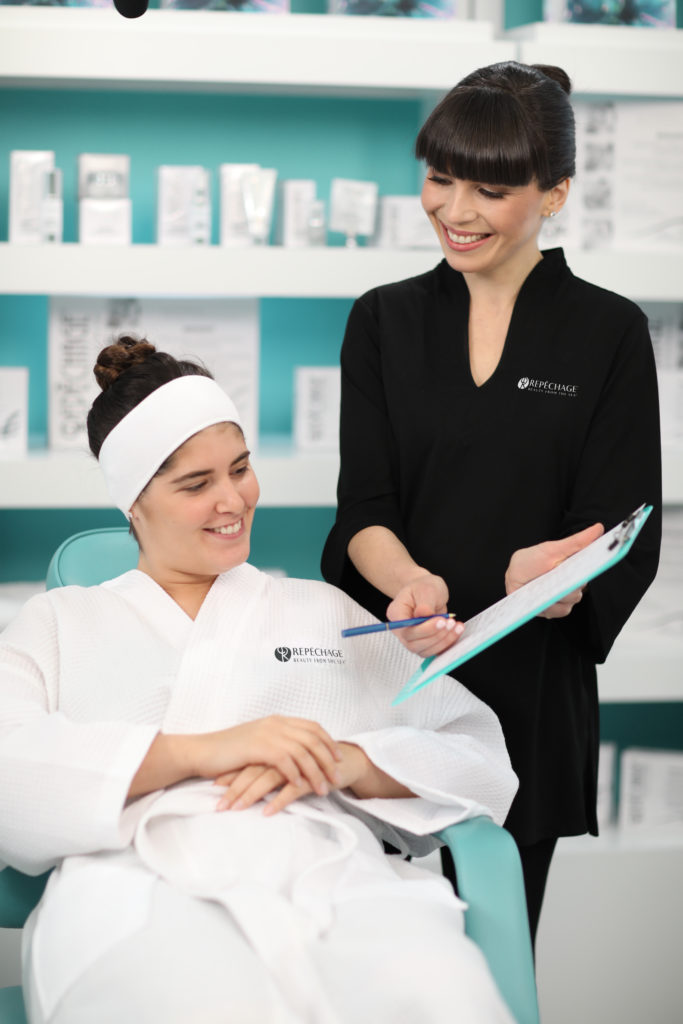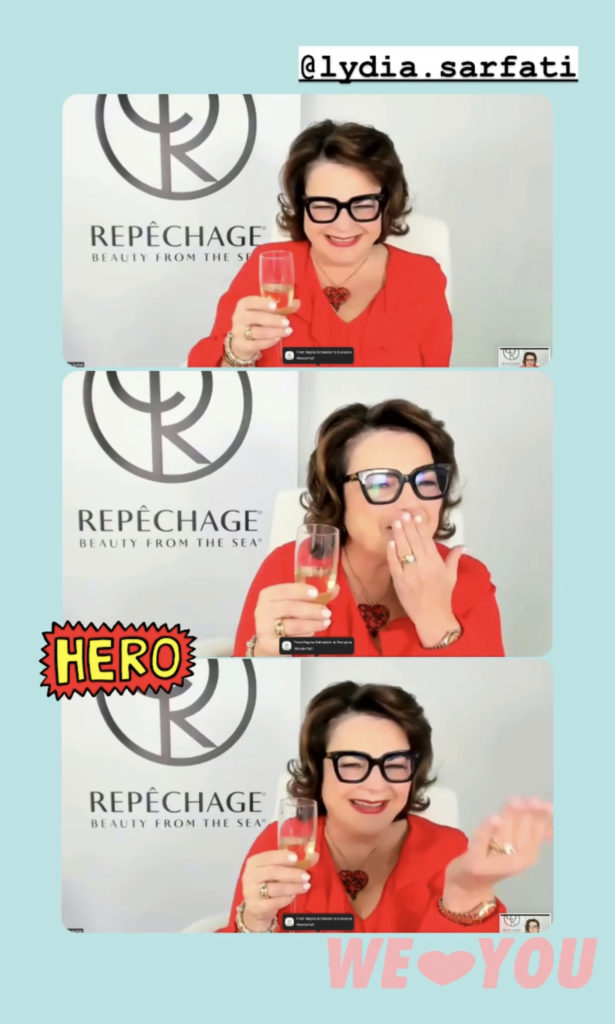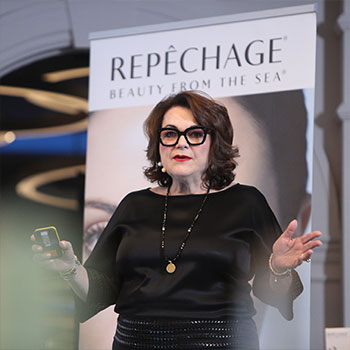 We are continuing our coverage of the presentations from the 2021 Repêchage Power Lunch to help everyone grow their business. Today, we are sharing Repêchage® Founder and CEO Lydia Sarfati’s invaluable advice on how to thrive through the upcoming decade. When it comes to sharing insights from her 40+ year career in the esthetics industry, like the E.F Hutton ad, when Lydia speaks, people listen.
We are continuing our coverage of the presentations from the 2021 Repêchage Power Lunch to help everyone grow their business. Today, we are sharing Repêchage® Founder and CEO Lydia Sarfati’s invaluable advice on how to thrive through the upcoming decade. When it comes to sharing insights from her 40+ year career in the esthetics industry, like the E.F Hutton ad, when Lydia speaks, people listen.
Sarfati is not only the pioneer of sustainably-harvested Seaweed-based skin care products, including the iconic Repêchage® Four-Layer Facial®, but is also President of CIDESCO Section USA, author of Success at Your Fingertips: How to Succeed in the Skin Care Business and The Repêchage Book of Skincare Science & Protocols and a contributing author to Oncology Esthetics in conjunction with Oncology Training International®, and the Milady Standard Esthetics: Fundamentals, Twelfth Edition, (Cengage Learning, 2019).
While previous presenters highlighted the importance of social media, on defining your brand and how to present luxury services without breaking the bank, Sarfati’s key takeaway was on how impeccable customer service and proper training in the Art of Recommendation can have a real impact on your business in dollars and cents.
The primary rule, according to Sarfati, is not to invest money in the most expensive décor or technology. “Invest the money in the best customer service,” says Sarfati, “And you will see your business grow.”
Here, we will outline Sarfati’s research and guidance on how to create luxury services and maintain clients to the benefit of your bottom line.
Good Customer Service Means Profit
According to research, 73% of all people point to customer experience as an important factor in their purchasing decisions, yet, only 49% of U.S. consumers say companies provide a good customer experience today.
The factors for creating a great experience does not mean more investment, however: Nearly 80% of American consumers point to speed, convenience, knowledgeable help and friendly service as the most important elements of a positive customer experience.
43% of all consumers say would pay more for greater convenience while 42% would pay more for a friendly, welcoming experience. These factors relate to one on one experiences, Sarfati points out, not just to investment in technology and social media.
“I love Facebook and Instagram and all of that, but do you know what? I’m going to tell you the truth. The best recommendation is still by word by mouth recommendation. Invest in the client that you have rather than putting all of your effort into getting more.”
Research confirms this. It has found that in the U.S., 65% find a positive experience with a brand to be more influential than great advertising. Conversely, 59% of consumers will walk away after several bad experiences, 17% after just one bad experience.
Make Your Business an Elite Spa or Salon
Sarfati suggests that no matter what the scale or location of your business, you should manage it as if it were a fine European boutique hotel or an elite restaurant. One of the benchmarks of fine hotel management is the Ritz Carlton, who empowers its employees to spend up to $2,000 to solve customer problems without asking for a manager. This figure isn’t arbitrary: The average Ritz-Carlton customer will spend $250,000 with the Ritz over their lifetime.
“Every single person at the Ritz is empowered to do well by the customer. Often, in our business, we talk about empowerment. What does that really mean?” Sarfati asked. “Ritz employees can spend up to $2,000 to solve customer problems. They don’t have to call the manager to find out if they can do it, okay? And this is an amazing feeling. One of the most frustrated feelings that customers can have is when they have to wait for someone to call up the management ladder. With this model, the staff is trained to solve problems instantly.”
Sarfati relates that the amount the staff is empowered to use does not have to be as high as the Ritz Carlton.
“Set your threshold based on a number that correlates to the amount spent by the client at your business over a lifetime. This can be anywhere from $200 to $500. Ask yourself how much you are willing to spend to make your clients’ experience exceptional without having to escalate to the manager. This was a very important lesson I learned when I had my spa near Park Avenue in Manhattan. I empowered the staff to use up to $300 to solve problems without calling anyone. That meant if someone left their bag at the spa, a staff member would take a cab to bring it to them, to do anything within that budget to create impeccable service. And you will see people are going to rave about your customer service.”
In order to make this happen, and for a day spa to be successful, the spa director (whether it be the owner or another employee) needs to be stationed at the front desk, anticipating clients’ needs and delivering services that are met with 100% satisfaction, says Sarfati.
Create Impeccable Service
How to make your spa’s experience impeccable? In order to deliver impeccable service and to truly delight your clients, according to Sarfati, you have to:
- Identify the demographic of your customer base
- Determine what it is that they want and how they wish to receive it
- Review your spa menu to see if it speaks to this affluent attitude.
- Create new ways to sell your current services so that they offer a more exclusive cachet.
The Power of Real Connection and Emotional Intelligence
Despite advances in technology, the human touch remains enormously important, said Sarfati. In fact, today, 64% of U.S. consumers and 59% of all consumers feel companies have lost touch with the human element of customer experience. 71% of Americans would rather interact with a human than a chatbot or some other automated process.
This means, in order to lead and create a successful business, you have to fully engage the minds, emotions and well-being of clients and staff. Emotional intelligence pushes the business to higher success in business and achieving organizational goals. This means developing composure skills and redirecting emotions in order to ensure “win-wins” and helping develop strategies that help to regulate both the staff’s ability to create a calm atmosphere while de-escalating any potential problems with the client. Training, to learn actionable skills for resiliency and stress management and to build bonds of connection by nurturing instrumental relationships in business are key.
Establishing a good relationship with the client is of the utmost importance, says Sarfati, yet emotional intelligence allows for a good relationship without too much familiarity.
“Clients cancelling on me five minutes before the appointment has not happened since 1977. Why? Because we were always friendly and very, very polite, but we were not familiar. Familiarity is what’s going to kill your business. You cannot get entangled in their problems, and they should not know about yours. The key words to remember are friendliness and empathy. If you treat your staff as gold, you treat your clients as gold, you will make gold as well. And service, service, service, warm, sincere greetings, and establishing great connection.”
 Establish Your Gold Standards with Staff and Clientele
Establish Your Gold Standards with Staff and Clientele
You don’t have to be the Ritz Carlton or Conrad Hilton to establish a gold standard of operations. To establish gold standard rules for your staff:
- Foster the idea that your business is a place where the genuine care and comfort of our guests is their highest mission.
- Pledge to provide the finest personal service and facilities for the clients who will always enjoy a warm, relaxed, yet refined ambience.
- Enlivens the senses, instills well-being, and fulfill the unexpressed wishes and needs of clients.
- Employ the motto: “We are Ladies and Gentlemen serving Ladies and Gentlemen.” This motto is the credo of the Ritz Hotel, and exemplifies the anticipatory service provided by all staff members.
- Sarfati has always instructed staff that it was important to refer to our clients as “Mrs. Smith,” rather than “Jane,” and the clients appreciated this respect.
Furthermore, Sarfati recommends fostering the following actions and attitudes need to be imparted to the staff to build strong relationships and create clients for life:
- A warm and sincere greeting.
- Use the guest’s name.
- Staff should be empowered to create unique, memorable and personal experiences for clients.
- Empowered to immediately resolve guest problems.
- Create a work environment of teamwork so that the needs of clients and other staff members are met.
- Continuously learn and grow through ongoing education
- Staff should show pride in their professional appearance, language and behavior.
- Come to work prepared and fully assessed of the day’s schedule
- Protect the privacy and security of clients, fellow employees and the company’s confidential information and assets.
- Fully anticipate and fulfill each guest’s needs by being responsive to the expressed and unexpressed wishes and needs of clients.
- Fond farewell. Give a warm good-bye and use the guest’s name.
Image is Everything
Although we like to think that most people don’t judge a book by its cover, unfortunately that is not the case, says Sarfati. The first seven seconds of a potential client’s initial encounter with your staff is critical to conveying your professional image. It is the details that impress your clientele and add value to your business.
What does your appearance and the appearance of the staff convey, asks Sarfati. “Take a picture of yourself. How do you look? Do you represent that high end clientele or do you look like you just rolled out of bed? Are you wearing flip-flops? You don’t have to spend a million to look professional. Great hair, impeccable grooming and manners, and carefully curated shoes show you care about yourself and can expertly guide your clients to looking and feeling better about themselves as well.”
A Checklist for Staff and Esthetician Appearance includes:
- Great hair: A good cut and color are must-haves. Be diligent about having hair that is not damaged or over-processed.
- Clear skin: You must have no visible blackheads, pimples or dryness. You cannot come to work with a blotchy, sun-damaged complexion.
- Well-groomed nails: Manicured, short nails with moist cuticles and soft hands look and feel professional.
- Professionally applied makeup: Less is more. Foundation is a must; powder, blush, lipstick and a good mascara are essential tools.
- Positive energy and a healthy lifestyle: A genuine smile, good posture and a firm handshake and use of proper etiquette.
The sight, sound, smell, and feel of the spa all play a role in creating judgements for potential customers. Do an honest evaluation of what the appearance of your facility conveys to a customer walking in the door. Use the five senses to enhance consumer’s engagement, and place the client at the center of all business strategies.
This means providing a full range of sensory experiences to help subconsciously gain the client’s trust and confidence in your authority, the authority of your spa or salon and the brand of skin care you are promoting.
One way to do this is to strive to employ all five senses when designing and selling:
Sight: Your displays should be neat and clean, six of each product, and bold marketing materials.
Sound: Slow, classical music will relax your clients and make them feel like they have time to peruse and shop.
Touch & Smell: Have samples of each product in your retail area. Your clients will like that they can touch and smell the products before they purchase them. Be sure that you are controlling the sampling process, if it is not well-maintained products can get messy and contaminated.
Taste: Offer your clients a beverage after their treatment. A drink will not only be a perfect end to their fantastic spa treatment, but it will also take your client a few minutes to consume.
Create a Boutique Spa Experience
Your environment further confirms your luxury appeal, says Sarfati. Be sure it as impeccable as the service. Some items on your checklist should contain:
- Your window is your spa’s calling card, and it should present an inviting impression of luxury, relaxation, meditation, wellness and pampering.
- Do not clutter windowsills or fill them with products that gather dust or fade from sun exposure.
- Likewise, your retail area should be designed like a boutique. It should be accessible, clean and organized.
- Further develop the boutique atmosphere in your spa by wrapping each purchase in tissue paper and placing it in a customized bag.
- A “wrapped gift” presentation adds perceived value.
- Hire an educated, well-groomed person to manage the front desk.
The Art of Recommendation
Retail sales are an essential part of a salon or spas business plan, but in order to properly sell retail, you need to have several environmental factors in place. Even before the esthetician starts to “sell,” the client has made a decision on whether or not to buy from the establishment.
Once you have established a gold standard in service and in the ambiance of the spa or salon, you can feel confident in creating a protocol for product recommendation that all the staff can fully engage in. The average spa and salon only charts less than 5% of their business to retail sales, Sarfati pointed out. A spa can be truly successful only if its retail sales equal or exceed the service sales. Depending on your spa or salon, retail sales should account for 50% of your gross revenue. By engaging in proper sales initiatives, you can increase profits by 100%
Sarfati acknowledged that “Many professionals fail to recommend products for their clients to purchase because some fear that their clients might not return as often if they are using salon-quality products at home. Actually, the opposite is true. Research has found that if you sell a client two retail products, there is a 60% chance of them returning to the spa or salon. One product, and there is a 30% chance of them returning. No product and there’s a scant 10% chance of them returning. There are some who think that recommending products makes them sound pushy. Well, it’s not pushy. You’re working hard. All we asking you to do is to now work smarter.”
Instructing staff on the Art of Recommendation is therefore imperative for your business’ success. To do this, establish within each protocol that after the treatment comes the recommendation period. This period includes the following actions:
- Show your client the visible improvements in the problem areas that were identified during the diagnosis step.
- Recommend the products that will further expand on this improvement.
- Put the product in your client’s hand, and explain how and when to use it.
- Be confident in your approach. When you prescribe with confidence, your clients will trust your expertise.
Establish the following rubric as part of your staff’s ongoing education in product recommendation:
- Listen: Take time to listen to the client explain their needs and concerns.
- Explain: Once you recommend, the client will want to know what the product does, how it works.
- Educate: Give details on how the ingredients and formulas will continue the benefits of the facial treatment they have enjoyed, helping to maintain the skin until their next appointment.
- Assist: Take the guess work out of their selection by helping them in making the right choice.
 Follow Up
Follow Up
Following up with the clients is one of the most effective ways to continue their loyalty. Be sure they are given recommendation for follow up appointments as well as products. Thank you notes need to be sent to clients after their appointments, as well as follow up emails and phone calls to see how their skin is progressing, if they have any questions about their prescribed skin care program, if they need replenishment, and as a reminder of upcoming appointments. Enlist social media to let them know they are privy to special deals and services at your business, that they are an “insider” and part of the family.
Being a business owner means you are part of a community, and creating a familial relationship with your clients will maintain their loyalty over a lifetime.
For more information on creating a five star experience, implementing staff initiatives and providing exceptional service, see Lydia Sarfati’s Success At Your Fingertips: How to Succeed In the Skin Care Business.
How do you create a luxury experience at your spa or salon? Let us know in the comments!


